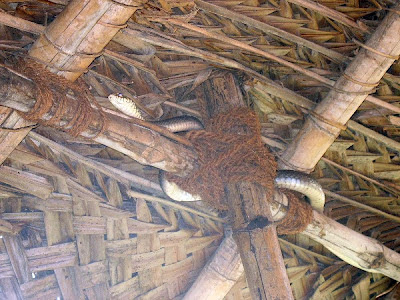The Pied Kingfisher is a water Kingfisher, which is widely distributed in India mainly on the plains. I have seen a number of Pied Kingfishers recently at the Samudram Erie (at the foot of Arunachala). And in my opinion this is one of the most unique and fascinating birds of the area.
The Pied Kingfisher is estimated to be the world’s third most common Kingfisher. Not only is the Pied Kingfisher the largest bird capable of a true hover in still air, it is also the only Kingfisher with all black and white plumage
The Pied Kingfisher is estimated to be the world’s third most common Kingfisher. Not only is the Pied Kingfisher the largest bird capable of a true hover in still air, it is also the only Kingfisher with all black and white plumage
 |
| Male Pied |
 |
| Adult Pied |
Males have a double band across the breast while females
have a single gorget that is often broken in the middle. This Kingfisher is
about 17 cm long and in size between a Mynah and a Pigeon. It also has the typical, stout, dagger-shaped bill
associated with other species of Kingfisher.
 |
| Female Pied |
This bird is usually found in pairs or small family parties.
When perched, it often bobs its head and flicks up its tail.
 |
| Pair of Pied Kingfishers |
This bird frequents rivers, jheels, irrigation tanks and
tidal creeks and can usually be seen perched on a favourite rock or stake near the
water. The Pied Kingfisher feeds mainly
on fish, although it will take frogs, crustaceans and large aquatic insects such
as dragonfly.
 |
| Pied Courtship Feeding |
It usually hunts by
hovering over the water to detect prey and diving vertically down bill-first to
capture fish. When not foraging, they have a straight rapid flight and have
been observed flying at nearly 32 mph. They call often on the wing, with
sharp chirruk chirruk notes.
 |
| Female Pied Kingfisher Hovering |
Its chief characteristic is its unique way of fishing. It
hovers stationary for considerable periods, 10m or so above the water,
‘standing on its tail’, and hurls itself, wings pulled in at the sides, at fish
coming up within striking depth. On emergence with the quarry, the bird flies
off to a convenient rock where the victim is battered before being swallowed.
However the Pied Kingfisher can deal with prey without
returning to a perch, often swallowing small victims in flight, and thus can hunt over large water
bodies or in estuaries that lack perches that are required by other Kngfishers.
 |
| Male Pied Kingfisher Hovering |
Unlike some other Kingfishers, the Piedi is quite gregarious, and forms
large roosts at night. The breeding
season is February to April. Its nest is a hole excavated in a vertical mud
bank about five feet above water. The nest tunnel is 4 to 5 feet deep and ends
in a chamber. Several birds may nest in the same vicinity. The usual clutch is
3-6 white eggs. Both sexes share excavation, and feeding the young
For a superb link with videos and photographs of the Pied Kingfisher go to this link here.
Amazing Video of Pied Kingfisher catching fish
The Pied Kingfisher is extremely agile in the air and hovers
far more often than other kingfishers. In
flight, it holds the body almost vertical, with the head and bill angled
sharply downwards, and beats the wings extremely rapidly. Kingfishers beat the reaction time of a fish
by 1/50th of a second. Hunting fish from the air, it seems, is harder than it
looks for the birds. Amazing rare nature photography in this video from BBC
Worldwide.











































